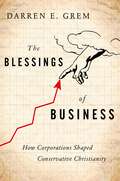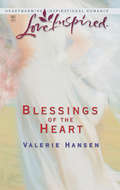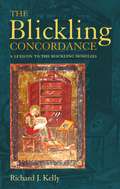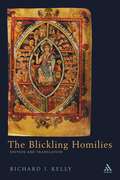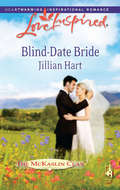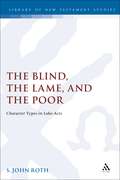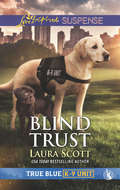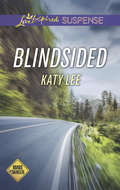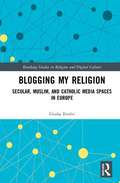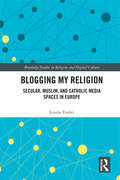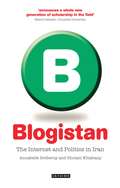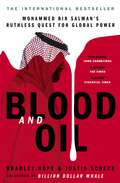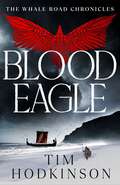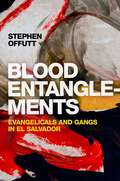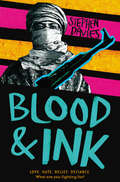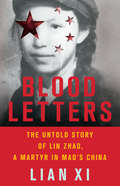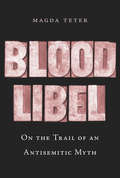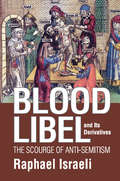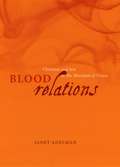- Table View
- List View
The Blessings of Business: How Corporations Shaped Conservative Christianity
by Darren E. GremThe Book of Matthew cautions readers that "Ye cannot serve God and mammon." But for at least a century conservative American Protestants have been trying to prove that adage wrong. In The Blessings of Business, Darren E. Grem argues that while preachers, activists, and politicians have all helped spread the gospel, American evangelicalism owes its enduring strength in a large part to private enterprise. Grem argues for a new history of American evangelicalism, demonstrating how its adherents strategically used corporate America--its leaders, businesses, money, ideas, and values--to advance their religious, cultural, and political movement. Beginning before the First World War, conservative evangelicals were able to use businessmen and business methods to retain and expand their public influence in a secularizing, diversifying, and liberalizing age. In the process they became beholden to pro-business stances on matters of theology, race, gender, taxation, trade, and the state, transforming evangelicalism itself into as much of an economic movement as a religious one. The Blessings of Business tells the story of unlikely partnerships between well-known champions of the evangelical movement such as Billy Graham and largely forgotten businessmen like Herbert Taylor, J. Howard Pew, and R.G. LeTourneau. Grem also shows how evangelicals set up their own pro-business organizations and linked the quarterly and yearly growth of "Christian" businesses to their social, religious, and political aspirations. Fascinating and provocative, The Blessings of Business uncovers the strong ties that conservative Christians have forged between the Almighty and the almighty dollar.
BLESSINGS OF BUSINESS C: How Corporations Shaped Conservative Christianity
by Darren E. GremThe Book of Matthew cautions readers that "Ye cannot serve God and mammon." But for at least a century conservative American Protestants have been trying to prove that adage wrong. In The Blessings of Business, Darren E. Grem argues that while preachers, activists, and politicians have all helped spread the gospel, American evangelicalism owes its enduring strength in a large part to private enterprise. Grem argues for a new history of American evangelicalism, demonstrating how its adherents strategically used corporate America--its leaders, businesses, money, ideas, and values--to advance their religious, cultural, and political movement. Beginning before the First World War, conservative evangelicals were able to use businessmen and business methods to retain and expand their public influence in a secularizing, diversifying, and liberalizing age. In the process they became beholden to pro-business stances on matters of theology, race, gender, taxation, trade, and the state, transforming evangelicalism itself into as much of an economic movement as a religious one. The Blessings of Business tells the story of unlikely partnerships between well-known champions of the evangelical movement such as Billy Graham and largely forgotten businessmen like Herbert Taylor, J. Howard Pew, and R.G. LeTourneau. Grem also shows how evangelicals set up their own pro-business organizations and linked the quarterly and yearly growth of "Christian" businesses to their social, religious, and political aspirations. Fascinating and provocative, The Blessings of Business uncovers the strong ties that conservative Christians have forged between the Almighty and the almighty dollar.
Blessings of The Heart (Mills And Boon Love Inspired Ser. #No. 206)
by Valerie HansenWriter Brianna Walker had moved to the Arkansas hills for a little peace and quiet. But the stormy night a handsome man, two bedraggled boys and a scruffy dog washed up in her front yard, Bree' s peaceful and quiet life became a thing of the past.
The Blickling Concordance: A Lexicon to The Blickling Homilies
by Richard J. KellyThis Concordance is a complete wordlist of the Blickling homiletic texts, which date from the late 10th century making them one of the earliest extant examples of prose writings in English. Each word is cited in standard dictionary form, expanded grammatically and referenced by line and page number to R. J. Kelly's edition and translation of The Blickling Homilies (Continuum, 2003). Frequently occurring words, such as prepositions and conjunctions, are cited in an Appendix, which also includes an outline of the principal linguistic structures of Old English. Important features of this Concordance include quick and straightforward cross referencing to the homiletic texts; identifying words from earlier Anglo-Saxon dialects; and the correction of scribal errors. The Concordance will be of particular interest to linguistics, cultural historians and researchers in various interdisciplinary fields.
Blickling Homilies: Edition and Translation
by Richard J. KellyThe Blickling Homilies date from the end of the tenth century and form one of the earliest extant collections of English vernacular homiletic writings. The homiletic texts survive in a composite codex consisting of Municipal Entries for the Council of Lincoln (14th - 17th century), a Calendar (mid 15th century), Gospel Oaths (early 14th century), and the eighteen homiletic texts that are based on the yearly liturgical cycle. The Blickling Homilies are an important literary milestone in the early evolution of the English prose. The manuscript, in the collection of William H. Scheide housed in Princeton University Library (MS. 71, s.x/xi), was published in facsimile by Rudolph Willard in 1960 as Volume 10 of Early English Manuscripts in Facsimile, Copenhagen. It is the only Anglo-Saxon MS still in private ownership, and together with The Blickling Psalter are the only two Anglo-Saxon MSS in the Americas. The only previous edition of The Blickling Homilies is by Richard Morris, published in three volumes in 1874, 1876, & 1880 (reprinted as one volume in 1967). This new edition makes a number of corrections where Morris's manuscript reading is in error. The English translations are modernized and made more accurate. The original text and facing-page translation have been formatted into paragraphs, which are hoped to further and aid comprehension. Finally, the text and translation are accompanied by a general introduction, textual notes on each homiletic text, tables and charts, and a select bibliography.
Blind-Date Bride (The McKaslin Clan #14)
by Jillian HartGetting stood up on a blind date was the best thing that could happen to police officer Max Decker. No small talk. No personal questions. No lies. And no pretending he's ready to give his heart to anyone. Anyone like vulnerable Brianna McKaslin–who was stood up in the same restaurant!
The Blind, the Lame and the Poor: Character Types in Luke-Acts (The Library of New Testament Studies #144)
by S. John RothThe virtual disappearance of the captive, the shattered, the blind, the deaf mute, the lame, lepers, the maimed, the dead and the poor from Acts poses a problem for Lukan studies. It creates a tension between two firmly held convictions about Luke's writing: that the Gospel and Acts are a unified work; and that Luke has a special concern for the poor. A fresh solution lies in tracing the intertextual links between Luke and the Septuagint. In the Septuagint, these character types are standard, conventional recipients of God's favour. In Luke's gospel, the primary function of these types is christological, in that Jesus' actions toward them reveal him to be God's unique eschatological agent of salvation. In Acts, however, there is a different Christological situation: Jesus is now the risen and ascended Lord, and so Luke has no need to foreground those, such as the poor, who in the Septuagint are especially destined for salvation.
Blind Trust (True Blue K-9 Unit #4)
by Laura ScottUSA TODAY Bestselling Author Laura Scott A puppy stolen, a woman in jeopardy… The next exciting True Blue K-9 Unit story
Blindsided: Dangerous Legacy Blindsided Fractured Memory (Roads to Danger #2)
by Katy LeeUNDERCOVER RESCUE
Blogging My Religion (Routledge Studies In Religion And Digital Culture Ser.)
by Giulia EvolviReligion in Europe is currently undergoing changes that are reconfiguring physical and virtual spaces of practice and belief, and these changes need to be understood with regards to the proliferation of digital media discourses. This book explores religious change in Europe through a comparative approach that analyzes Atheist, Catholic, and Muslim blogs as spaces for articulating narratives about religion that symbolically challenge the power of religious institutions. The book adds theoretical complexity to the study of religion and digital media with the concept of hypermediated religious spaces. The theory of hypermediation helps to critically discuss the theory of secularization and to contextualize religious change as the result of multiple entangled phenomena. It considers religion as being connected with secular and post-secular spaces, and media as embedding material forms, institutions, and technologies. A spatial perspective contextualizes hypermediated religious spaces as existing at the interstice of alternative and mainstream, private and public, imaginary and real venues.
Blogging My Religion (Routledge Studies In Religion And Digital Culture Ser.)
by Giulia EvolviReligion in Europe is currently undergoing changes that are reconfiguring physical and virtual spaces of practice and belief, and these changes need to be understood with regards to the proliferation of digital media discourses. This book explores religious change in Europe through a comparative approach that analyzes Atheist, Catholic, and Muslim blogs as spaces for articulating narratives about religion that symbolically challenge the power of religious institutions. The book adds theoretical complexity to the study of religion and digital media with the concept of hypermediated religious spaces. The theory of hypermediation helps to critically discuss the theory of secularization and to contextualize religious change as the result of multiple entangled phenomena. It considers religion as being connected with secular and post-secular spaces, and media as embedding material forms, institutions, and technologies. A spatial perspective contextualizes hypermediated religious spaces as existing at the interstice of alternative and mainstream, private and public, imaginary and real venues.
Blogging My Religion: Secular, Muslim, and Catholic Media Spaces in Europe (Routledge Studies in Religion and Digital Culture)
by Giulia EvolviReligion in Europe is currently undergoing changes that are reconfiguring physical and virtual spaces of practice and belief, and these changes need to be understood with regards to the proliferation of digital media discourses. This book explores religious change in Europe through a comparative approach that analyzes Atheist, Catholic, and Muslim blogs as spaces for articulating narratives about religion that symbolically challenge the power of religious institutions. The book adds theoretical complexity to the study of religion and digital media with the concept of hypermediated religious spaces. The theory of hypermediation helps to critically discuss the theory of secularization and to contextualize religious change as the result of multiple entangled phenomena. It considers religion as being connected with secular and post-secular spaces, and media as embedding material forms, institutions, and technologies. A spatial perspective contextualizes hypermediated religious spaces as existing at the interstice of alternative and mainstream, private and public, imaginary and real venues. By offering the innovative perspective of hypermediated religious spaces, this book will be of significant interest to scholars of religious studies, the sociology of religion, and digital media.
Blogging My Religion: Secular, Muslim, and Catholic Media Spaces in Europe (Routledge Studies in Religion and Digital Culture)
by Giulia EvolviReligion in Europe is currently undergoing changes that are reconfiguring physical and virtual spaces of practice and belief, and these changes need to be understood with regards to the proliferation of digital media discourses. This book explores religious change in Europe through a comparative approach that analyzes Atheist, Catholic, and Muslim blogs as spaces for articulating narratives about religion that symbolically challenge the power of religious institutions. The book adds theoretical complexity to the study of religion and digital media with the concept of hypermediated religious spaces. The theory of hypermediation helps to critically discuss the theory of secularization and to contextualize religious change as the result of multiple entangled phenomena. It considers religion as being connected with secular and post-secular spaces, and media as embedding material forms, institutions, and technologies. A spatial perspective contextualizes hypermediated religious spaces as existing at the interstice of alternative and mainstream, private and public, imaginary and real venues. By offering the innovative perspective of hypermediated religious spaces, this book will be of significant interest to scholars of religious studies, the sociology of religion, and digital media.
Blogistan: The Internet and Politics in Iran (International Library Of Iranian Studies)
by Annabelle Sreberny Gholam KhiabanyThe protests unleashed by Iran's disputed presidential election in June 2009 brought the Islamic Republic's vigorous cyber culture to theworld's attention. Iran has an estimated 700,000 bloggers, and new media such as Facebook, Twitter and YouTube were thought to haveplayed a key role in spreading news of the protests. The internet is often celebrated as an agent of social change in countries like Iran, but most literature on the subject has struggled to grasp whatthis new phenomenon actually means. How is it different from printculture? Is it really a new public sphere? Will the Iranian blogospherecreate a culture of dissidence, which eventually overpowers the Islamist regime? In this groundbreaking work, the authors give a flavour of contemporary internet culture in Iran and analyse how this new form of communication is affecting the social and political life of the country. Although they warn against stereotyping bloggers as dissidents, they argue that the internet is changing things in ways which neither the government nor the democracy movement could have anticipated. Blogistan offers both a new reading of Iranian politics and a new conceptual framework for understanding the politics of the internet, with implications for the wider Middle East, China and beyond.
Blood and Oil: Mohammed bin Salman's Ruthless Quest for Global Power
by Bradley Hope Justin Scheck"Blood and Oil is the fascinating and highly entertaining tale of Mohammed bin Salman's rise to power. With fly-on-the-wall reporting and palace intrigue worthy of Machiavelli, it will keep you turning the pages at a fast clip until its tragic denouement. And more importantly, it will leave you with a deep and nuanced understanding of the Crown Prince's thinking and its implications for Saudi Arabia and the entire Middle East." - John Carreyrou, author of Bad BloodThirty-five-year-old Mohammed bin Salman's sudden rise stunned the world. Political and business leaders such as former Prime Minister Tony Blair and WME Chairman Ari Emanuel flew out to meet with the Crown Prince and came away convinced that his desire to reform the kingdom was sincere. He spoke passionately about bringing women into the workforce and toning down Saudi Arabia's restrictive Islamic law. He lifted the ban on women driving and explored investments in Silicon Valley.But 'MBS' began to betray an erratic interior beneath the polish laid on by scores of consultants and public relations experts like McKinsey & Company. The allegations of excess and about the brutality of his regime began to slip out. Then there was the assassination of journalist Jamal Khashoggi. While stamping out dissent in the Saudi royal family by holding three hundred members in the Ritz-Carlton Hotel for months, he continued to exhibit his extreme wealth, including the purchase of a $70 million chateau in Europe and one of the world's most expensive yachts. It seemed that he did not understand nor care about how the outside world would react to his flexing of autocratic muscle."This is as close to the truth, to the real story of the corruption, vulgarities, horrors, and lies of the Kingdom and its current despot as we are likely to get. It also can be read as a Shakespearean story of utter greed." - Seymour Hersh, author of Chain of Command
Blood Eagle (The Whale Road Chronicles)
by Tim HodkinsonEinar and the Wolf Coats undertake a dangerous mission to war-torn Northern France in this thrilling Viking adventure from Tim Hodkinson.936 AD. Brittany is torn apart by war. Many nobles have sought refuge in King Aethelstan's England, including Louis, prospective king of Francia. Einar and the Wolf Coats, disillusioned by events in Norway, are also at Aethelstan's court.When Louis decides to take up his throne, Aethelstan sees a way to make a crucial ally: a powerful noble whose support Louis needs. And Aethelstan has just the men he needs to carry his message... and undertake a secret mission.The Wolf Coats' quest is fraught with danger and foreboding, for the world is changing. Pagan kings clash with Christians, Vikings assail Francia, and Einar and his crewmates risk death at the centre of the storm.Reviewers on Tim Hodkinson'Will appeal to fans of Bernard Cornwell, George R.R. Martin, and especially Theodore Brun' Historical Novel Society 'A gripping action adventure like the sagas of old' Melisende's Library 'An excellently written page-turner' Historical Writers Association
Blood Entanglements: Evangelicals and Gangs in El Salvador
by Stephen OffuttIn many low-income neighborhoods in El Salvador, two groups have significant influence over the public sphere: gangs and evangelical churches. Members of both groups often belong to the same families, use similar organizational strategies, and engage each other in local marketplaces. Pastors and gang leaders compete for power within communities while informally sharing community governance. Entanglements even occur within formal organizations: Gang members can be found in churches and faith-based organizations, while an evangelical presence exists within prisons and other gang-controlled spaces. Blood Entanglements shows the importance of religion in gang-controlled neighborhoods in El Salvador through extensive empirical data and the personal stories of people who live there. Stephen Offutt uses the notion of "entanglement" to explain how and why evangelicals have such frequent and often intimate interactions with gangs, which are groups that many evangelicals believe are evil. Entanglement, he shows, also sheds light on how evangelicals engage with Latin American society and social problems more generally. The book concludes with policy recommendations for reducing gang prevalence and violence in areas with a prominent evangelical presence.
Blood Entanglements: Evangelicals and Gangs in El Salvador
by Stephen OffuttIn many low-income neighborhoods in El Salvador, two groups have significant influence over the public sphere: gangs and evangelical churches. Members of both groups often belong to the same families, use similar organizational strategies, and engage each other in local marketplaces. Pastors and gang leaders compete for power within communities while informally sharing community governance. Entanglements even occur within formal organizations: Gang members can be found in churches and faith-based organizations, while an evangelical presence exists within prisons and other gang-controlled spaces. Blood Entanglements shows the importance of religion in gang-controlled neighborhoods in El Salvador through extensive empirical data and the personal stories of people who live there. Stephen Offutt uses the notion of "entanglement" to explain how and why evangelicals have such frequent and often intimate interactions with gangs, which are groups that many evangelicals believe are evil. Entanglement, he shows, also sheds light on how evangelicals engage with Latin American society and social problems more generally. The book concludes with policy recommendations for reducing gang prevalence and violence in areas with a prominent evangelical presence.
Blood & Ink
by Stephen DaviesKadija is the music-loving daughter of a guardian of the sacred manuscripts of the ancient city of Timbuktu, Mali.Ali is a former shepherd boy, trained as a warrior for Allah.Tonight, the Islamist rebels are coming for Timbuktu. They will install a harsh regime of law and tear apart the peaceful world within the mud walls of the city. Television, football, radios, even music, will be banned. Kadija refuses to let go of her former life. And something in her defiance draws Ali to her.Which path will he choose?
Blood Letters: The Untold Story of Lin Zhao, a Martyr in Mao's China
by Lian XiThe staggering story of the most important Chinese political dissident of the Mao era, a devout Christian who was imprisoned, tortured, and executed by the regimeBlood Letters tells the astonishing tale of Lin Zhao, a poet and journalist arrested by the authorities in 1960 and executed eight years later, at the height of the Cultural Revolution. The only Chinese citizen known to have openly and steadfastly opposed communism under Mao, she rooted her dissent in her Christian faith -- and expressed it in long, prophetic writings done in her own blood, and at times on her clothes and on cloth torn from her bedsheets. Miraculously, Lin Zhao's prison writings survived, though they have only recently come to light. Drawing on these works and others from the years before her arrest, as well as interviews with her friends, her classmates, and other former political prisoners, Lian Xi paints an indelible portrait of courage and faith in the face of unrelenting evil.
Blood Libel: On the Trail of an Antisemitic Myth
by Magda TeterDrawing on sources in eight countries and ten languages, Magda Teter tells the history of the antisemitic blood libel myth, whose long shadow extends from premodern monastic chronicles to Facebook. The vocabulary and images that crystallized and spread with the invention of the printing press are still with us, as are their pernicious consequences.
Blood Libel and Its Derivatives: The Scourge of Anti-Semitism
by Raphael IsraeliAt the doorstep of the twenty-first century, one would expect that medieval concepts such as blood libel—the accusation that Jews kill children to use their blood in religious ritual—would have been discarded by any civilized human being. Certainly in the Christian world, where the story originated and endured for centuries, modern attitudes have nearly erased these barbaric accusations. But in Arab and Islamic worlds, where enmity towards Israel and Zionism has conditioned beliefs, attitudes, positions, and fantasies, blood libel and similar charges are still part of life.Most people are unaware of the history of blood libel and do not perceive links between it and many of the false accusations currently hurled against the state of Israel. Raphael Israeli argues that individuals and organizations guilty of human rights crimes project crimes onto Israel to avoid awareness of their own guilt. Certainly when countries ruled by dictators set the agenda of the UN Council for human rights, Israel is consistently censured and condemned.Accusations of "apartheid" and charges of discrimination against Muslims are frequently made. Israel is accused of plots against Muslims in order to harm their productive sectors, of using weapons of mass destruction to commit "genocide" against Arabs, of injecting poisonous substances into Palestinian children, of poisoning Arab lands under the guise of "agricultural aid," and of laying siege to peaceful citizens. All of these charges are derivatives of blood libel and have been adopted by Middle East Jihadists in their struggle against Israel. This volume aims to explain the origins of the charge of blood libel and define the ways its derivatives have achieved acceptance in certain parts of the world today.
Blood Libel and Its Derivatives: The Scourge of Anti-Semitism
by Raphael IsraeliAt the doorstep of the twenty-first century, one would expect that medieval concepts such as blood libel—the accusation that Jews kill children to use their blood in religious ritual—would have been discarded by any civilized human being. Certainly in the Christian world, where the story originated and endured for centuries, modern attitudes have nearly erased these barbaric accusations. But in Arab and Islamic worlds, where enmity towards Israel and Zionism has conditioned beliefs, attitudes, positions, and fantasies, blood libel and similar charges are still part of life.Most people are unaware of the history of blood libel and do not perceive links between it and many of the false accusations currently hurled against the state of Israel. Raphael Israeli argues that individuals and organizations guilty of human rights crimes project crimes onto Israel to avoid awareness of their own guilt. Certainly when countries ruled by dictators set the agenda of the UN Council for human rights, Israel is consistently censured and condemned.Accusations of "apartheid" and charges of discrimination against Muslims are frequently made. Israel is accused of plots against Muslims in order to harm their productive sectors, of using weapons of mass destruction to commit "genocide" against Arabs, of injecting poisonous substances into Palestinian children, of poisoning Arab lands under the guise of "agricultural aid," and of laying siege to peaceful citizens. All of these charges are derivatives of blood libel and have been adopted by Middle East Jihadists in their struggle against Israel. This volume aims to explain the origins of the charge of blood libel and define the ways its derivatives have achieved acceptance in certain parts of the world today.
Blood Relations: Christian and Jew in The Merchant of Venice
by Janet AdelmanIn Blood Relations, Janet Adelman confronts her resistance to The Merchant of Venice as both a critic and a Jew. With her distinctive psychological acumen, she argues that Shakespeare’s play frames the uneasy relationship between Christian and Jew specifically in familial terms in order to recapitulate the vexed familial relationship between Christianity and Judaism. Adelman locates the promise—or threat—of Jewish conversion as a particular site of tension in the play. Drawing on a variety of cultural materials, she demonstrates that, despite the triumph of its Christians, The Merchant of Venice reflects Christian anxiety and guilt about its simultaneous dependence on and disavowal of Judaism. In this startling psycho-theological analysis, both the insistence that Shylock’s daughter Jessica remain racially bound to her father after her conversion and the depiction of Shylock as a bloody-minded monster are understood as antidotes to Christian uneasiness about a Judaism it can neither own nor disown. In taking seriously the religious discourse of The Merchant of Venice, Adelman offers in Blood Relations an indispensable book on the play and on the fascinating question of Jews and Judaism in Renaissance England and beyond.
Blood Relations: Christian and Jew in The Merchant of Venice
by Janet AdelmanIn Blood Relations, Janet Adelman confronts her resistance to The Merchant of Venice as both a critic and a Jew. With her distinctive psychological acumen, she argues that Shakespeare’s play frames the uneasy relationship between Christian and Jew specifically in familial terms in order to recapitulate the vexed familial relationship between Christianity and Judaism. Adelman locates the promise—or threat—of Jewish conversion as a particular site of tension in the play. Drawing on a variety of cultural materials, she demonstrates that, despite the triumph of its Christians, The Merchant of Venice reflects Christian anxiety and guilt about its simultaneous dependence on and disavowal of Judaism. In this startling psycho-theological analysis, both the insistence that Shylock’s daughter Jessica remain racially bound to her father after her conversion and the depiction of Shylock as a bloody-minded monster are understood as antidotes to Christian uneasiness about a Judaism it can neither own nor disown. In taking seriously the religious discourse of The Merchant of Venice, Adelman offers in Blood Relations an indispensable book on the play and on the fascinating question of Jews and Judaism in Renaissance England and beyond.
